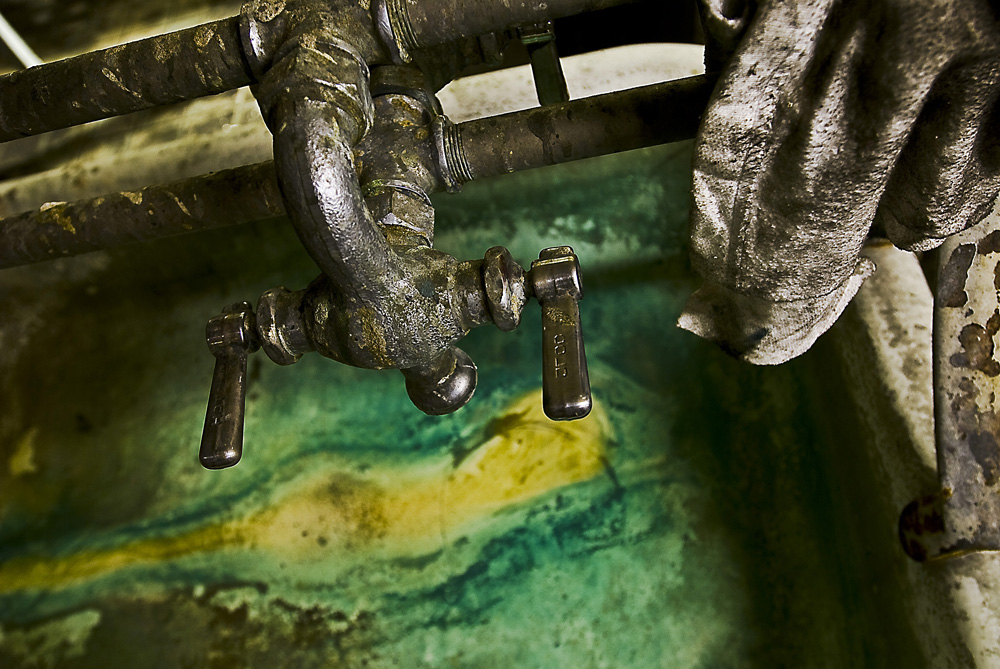Back in Ought 8, I interned at the Indianapolis Star newspaper in Indianapolis. In the basement of the building, a dead spaced existed. It used to hold their printing press, which were often built into the foundation during original construction of a newspaper. But several years prior, they ripped it out and sold it for parts because it couldn’t handle the demands of present-day printing. This process of ripping and selling, and then printing off-site is quite common for newspapers, especially any of considerable age.
If you’ll recall, 2008 was the noticeable beginning of The Great Recession. So I took my camera down to this dilapidated basement and started spending hours taking long-exposure photos. To me it was a project both documenting and commenting on the state of newspapers. It drew a parallel between the past and future where we had a chance to decide what to do next. I was telling a story with ink spills. It was very much my story though. I used the space to express my feelings about the industry. I found old pictures of the press in the library that created this dichotomy even more but am unfortunately not allowed to publish them since the rights are held by another company.
The reaction from the newsroom was mixed but largely positive. Some people cried – those who’d worked at the newspaper before the press sold. The editor enjoyed them and said that, at the least, they should clean up the enormous mess as he was sure it violated numerous codes.
The Press

Buttons that once controlled the conveyor belts have been severed.

On the first floor of the press room, this set of doors was found in a large, destroyed locker room. The room appears to have been a gathering place for many people throughout the years with magazines, clothes and other personal items still about.

On the first floor of the press room, this destroyed locker room was found. The room appears to have been a gathering place for many people throughout the years with magazines, clothes and other personal items scattered about.

On the floor lie a teaching coloring book game called “Reading Blaster!” next to a pack of crayons, markers, books and clothes. Many other children’s games can be found scattered throughout this area of the main locker room on the first flloor of the press room.

This Aug. 26, 1991 issue of JET magazines features Danny Glover and Martin Short and asks why Danny Glover “dropped the tough-guy image for comedy.” Other JET magazines from the same year featured Michael Jordan and early ’90s rap artists.

No-doz was a popular choice for many people on the late shift before energy drinks took its place.

This large old-style bathroom is down the stairs – as can be seen in the mirror at top right – from the main locker room. Several sinks had “out of order” signs on them and one urinal had been ripped from the wall and placed inside a stall. The showers still had wet stains on the floor. The purple, mostly dead flourescent light cast eerie shadow into the room from the irregularly shaped fixtures.

This faucet continues to drip water every few seconds, creating a pull of calcifying water and decaying porcelain in sink basin. Ink stained rags, plastic gloves and greasy fixtures fill the sink, floors and shelves of this bathroom which appears to have gone unused for many years.

This sign is found on the second level of the former press and warns pressman not to paper rollers while moving.

The printing press in the previous picture used to be here, in the basement of The Indianapolis Star building. The printing presses were built into the foundation of the building and literally had to be ripped out upon removal, causing scarring and severe damage to the cement floor.

This room contains the controls for ink pressure, flow and quantity.

A large pipe sticks into this room, still dripping black ink onto the control panel.

A broken barrel of ink leaks onto the messy floor.

Magenta and Yellow ink stains are left behind in one of the press’ left over holes in the foundation.

A single handtruck sits alone, possibly untouched for years in the basement press room.

Conveyor belts, which were used to sort direct mail, ads and newspaper bundles, now hide behind mounds of unused equipment, from newsstands to computer screens. The mailroom, a once loud room full of people and machines, is a quiet graveyard.

In the mailroom, the final stage of a newspaper before being loaded onto a delivery truck, this sign is posted in several places, reminding workers that newspapers are not free.


















